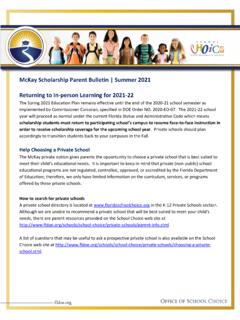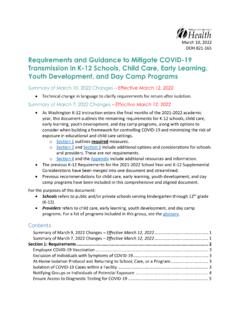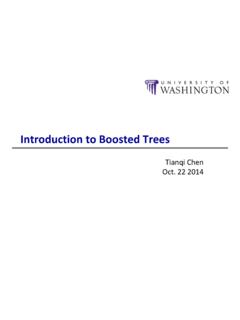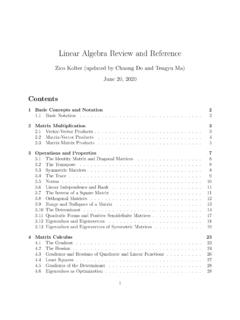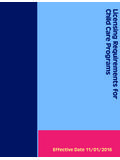Transcription of The Effect of Flexible Learning Schedule on Online ...
1 1060 The Effect of Flexible Learning Schedule on Online Learners Learning , Application, and Instructional Perception Doo H. Lim University of Tennessee Learning style has been an important area of study to improve learner satisfaction and Learning outcomes. This study examined the Effect of Flexible Learning Schedule on Learning and application of Learning made by a group of undergraduate students. Results revealed Flexible Learning Schedule influenced students Learning . Various reasons why respondents in the study attained high or low degree of perceived Learning and application of Learning are provided.
2 Discussions about instructional conditions and strategies to enhance Learning and application of Learning were included. Keywords: Online Learning , Learning Preferences, Learning Application Identifying different types of Learning styles and their impacts on student Learning has been a major field of study in distance education (Ehrman, 1990; Riding & Cheema, 1991; Smith, 1997). From numerous research studies, satisfying Online learner s Learning style and preference was considered a critical success factor for Online instruction (Blickle, 1996; De Raad, 1996; Goff & Ackerman, 1992; Vermunt, 1998; Wolfe & Johnson, 1995).
3 Among many studies focusing on cognitive style and Learning preferences, learner s control of Learning process was a frequently studied topic in distance education because the Online delivery medium has transferred control of Learning from instructor to each individual learner (El-Tigi & Branch, 1997). While traditional classroom instruction requires learner to follow certain sequence bounded by time, content, and place, Online instruction allows Flexible Learning modes so students can control their Learning path, pace, and contingencies of instruction (Hannafin, 1984).
4 The more the learners can control individual Learning environment, the greater chances the learners will motivate their own Learning (Steinberg, 1989). As more adult learners seek for college education delivered through distance education methods, satisfying the Learning needs and preferences of this learner population has become a major issue in Online instruction. Higher education institutions such as colleges and universities, however, have not been fully meeting the adult learners Learning needs to have more accessible, Flexible , and convenient ways to take classes.
5 According to MacDonald, Stodel, Farres, Breithaupt, and Gabriel (2001), the characteristics of adult learners who will be best served by the benefits of Online instruction are: a) working adults, b) adults who cannot afford long leaves of absence, c) single parents or economically disadvantaged adults, and d) those who need an alternative way to study degree programs for economic, social, personal, or practical reasons. Online instruction, in this regard, has been considered a viable option to satisfy such unique Learning needs of adult learners.
6 Among various conditions for adult learners to control their own Learning , learner s self control of the time, sequence, and pace of Learning were identified as the major Learning preferences needed to be addressed in higher education (Lin & Hsieh, 2001). Even though many studies have verified the Effect of self-control over the Learning sequence and path during Online Learning , very few empirical research studies have conducted to identify the Effect of self-control of Learning Schedule on the Learning , application of Learning , and instructional experience of Online learners.
7 Here, the term application of Learning refers to the degree to which learners use and apply learned knowledge and skills during instruction or to current and future jobs. Questions for Investigation The purpose of this study was to examine if Online learner s Learning , application of Learning , and instructional quality perceived by a group of undergraduate students who took an Online course with Flexible Learning Schedule differ from those perceived by the other group of students who took the same course with fixed Learning Schedule .
8 Several research questions were developed to investigate the purpose of this study. 1. Do Learning and application of Learning differ between the Flexible and the fixed Learning Schedule group? 2. What instructional factors and conditions promote or hinder Learning and Learning application of the different Schedule groups? Copyright 2004 Doo H. Lim 49-1 1061 Methodology This study utilized quantitative research methods. To assess Learning and Learning application differences between the different Schedule option groups of the Online course, a group of undergraduate students were asked to participate in this study.
9 The subjects for the study included 102 students (34 male and 68 female) who took an Online course at a southeastern university. Among the 102 students, 55 students chose the fixed Learning Schedule and 47 students chose the Flexible Learning Schedule . Regarding employment status, 16 students were fulltime students, 38 students had part-time jobs, and 48 students had fulltime jobs. A questionnaire was developed to obtain the students perceived degree of Learning , Learning application, and instructional quality of the Online course.
10 The questionnaire included question items composed of the eighteen Learning objectives of the course. The students were asked to participate the pre and post survey conducted Online at the beginning and at the end of each semester. The data sets were collected for all terms including Spring, Fall, and summer terms between year 2000 and 2002. The Online questionnaire used a five point Likert-type scale to measure the degree of Learning (1 for "do not understand" to 5 for "completely understand") and application of Learning (1 for "none" to 5 for "frequently use").











